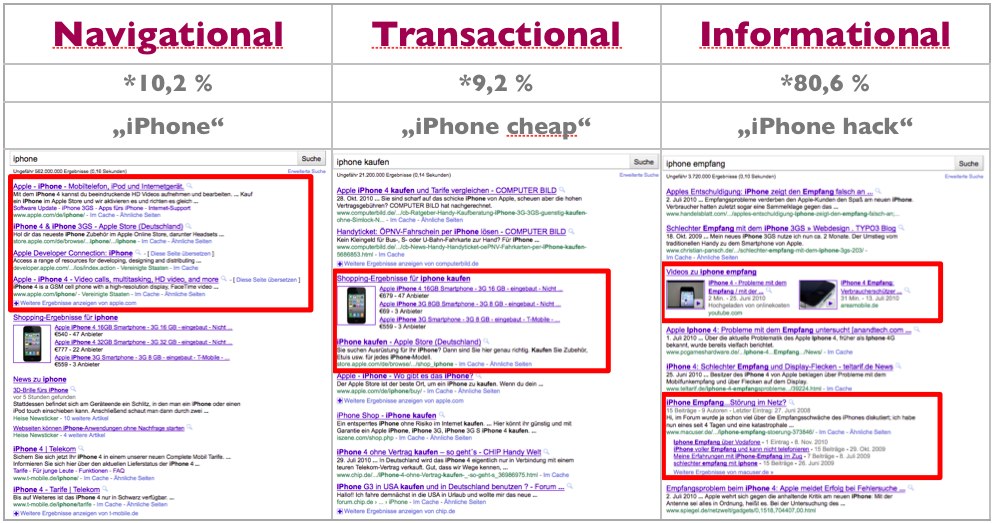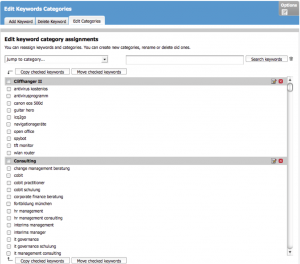Today we’re looking at keywords. With a reasonably large site it is simply impossible to keep an eye on all (!) search terms. The Searchmetrics Suite Performance module already identifies 100,000 or 300,000 searches for which a domain is found. So how do you manage an overview of all this? It would be wrong to only monitor the biggest and most important keyword positions and at the same time lose sight of the Long Tail. So, how do we deal with different keywords? And what kind of keyword types are there actually?

We know that a user has many different expectations of Google when they enter “iphone”, “buy iphone”, “iphone reception”, “iphone contract Munich” or “steve jobs”. Search results for one of these enquiries will show local sites, while for others we will find four pages from Apple, an integrated shopping link or a portrait image of Uncle Steve. What’s happening here? How does Google do this and how can I show this in an analysis?
That’s a lot of questions for us to answer. However first we need a little theory:
Long Tail vs. Short Tail:
To begin with there is the usual distinction for keywords between the Long Tail and the Short Tail – with some also using the term Mid Tail. An explanation of these keyword categories is unnecessary in SEO circles. However, perhaps a small tip for optimization – with long-tail keywords I would concentrate more on on-site optimization, whereas short-tail blockbusters are more suited to off-site measures. But this is not a hard and fast rule.
Navigational vs. Transactional vs. Informational:
The second dimension begins when the suspected informational need of the searcher is assumed. This is a matter of navigation vs. transaction vs. information.

The percentage figures in this graph come from a somewhat older study but they are however still applicable. And if we compare the search results for “buy iphone” (transactional) with “iphone reception” (informational) and “apple” (navigational) we quickly see a couple of differences:
Firstly, the layout of the page is totally different. Each has a different OneBox. Secondly the results are from totally different areas. ‘Navigational’ results can display many pages from the same domain. In ‘transactional’ results shops dominate, whereas news sites and forums dominate ‘informational’ results. And this doesn’t simply apply to optimization efforts but also to the categorization of Google pages.
Perhaps take this as a tip for optimization – focus above all else on keywords that fit you and your business. Someone trying to get a magazine site on the first page for the keywords “buy iphone”, is going to have a very, very hard time of it.
Universal Search
And then there is still the Universal Search categorization: as soon as there is a place name in the search term or a search term suggesting a local area search (e.g. Doctor), a map appears. Someone searching for “Mona Lisa” will logically see images etc…
Keyword categories in search analysis
So much for the theory – there are certainly different keyword categories that also overlap each other. A transactional keyword can of course be long-tail or short-tail and possibly ‘current’ enough that there is even a corresponding news OneBox…
Therefore I have the following tip – don’t organize your keywords thematically (or least not only) according to your categories (it doesn’t matter if they’re content channels or product categories). Instead allow yourself, in principle, to sort keywords into the following categories.
- Long Tail
- Mid Tail
- Short Tail
- Transactional
- Informational
- Navigational
- News
- Images
- Video
- Products
- Local
Of course not every website will need every category. But sometime a shop will build topic pages in which case it’s a good thing if you already have an informational category in place.
Please note – every page is essentially a little ‘current’, ‘informative’ etc. Certainly one of these attributes will dominate – but the other are still at least somewhat present.
And especially when you’re dealing with large websites experiencing surges and falls, it’s critical to know where this is actually happening. Web analysis does not always tell us everything – so it’s good that Searchmetrics Suite is prepared for this.
If i have a ‘Long Tail’ and a ‘Short Tail’ category, I can see with a a single glance after a drop in visibility whether I’m being affected by a delayed MayDay update or whether two or three Short Tail keywords have been broken off. Agencies in particular are going to appreciate the advantage of keywords that are standardized in this way.
Firstly, it means less work in providing your next clients with some ready-made basic categories. And secondly, you can recognize what effect an update has had with a client across all their pages.
And now once more something wholly practical on the categorization of keywords:

- Analysis is always the result of lots of figures and not simply the study of exceptions. You can of course choose to observe samples only – but these should be well selected and adequate to the task at hand. I would say that each of the categories above with 50 keywords is well described – but you also have to develop your own feel for this.
- Categories are of course best allocated when entering keywords.
- An overview of all categories for a domain can be found under “Keywords / Positions / Keyword Categories”. For the unfortunately necessary post-processing of existing keywords into new categories go to “Keywords / Edit / Edit categories”. (See the picture above)
- And – if these categories are used in the Suite for many domains, then an additional category should be created for each client. Believe me, one day this will save you a lot of time. But you will come to realize that soon enough.